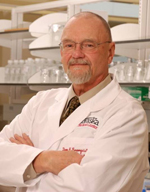 |
Don Leuenberger |
 |
Tom Rosenquist, Ph.D. |
The proposal raised the cost of the 11,825-square-foot building from $12.5 million to $16.5 million. The facility, a joint project between UNMC and its hospital partner, The Nebraska Medical Center, sits on two levels on the south side of the Academic and Research Services building on the southwest corner of the intersection of 42nd Street and Emile Street. It has previously been referred to as a current Good Manufacturing Practices (cGMP) facility.
The cGTP facility is necessary for UNMC to comply with federal regulations governing the manufacture and clinical use of cells, tissues and their products. Patients with cancer, diabetes and liver failure will benefit from the facility.
The original program statement for the cGTP facility was approved by the Board of Regents in January 2004. This program statement was based on meeting the functional medical and scientific needs to be performed in the facility, as understood at that time, as compared to similar facilities, said Don Leuenberger, vice chancellor for business and finance.
Well into the project design, however, the Food and Drug Administration (FDA) stipulated that 100 percent outside air must be supplied to all clean rooms in the facility instead of re-circulated air as has been the practice. An additional FDA stipulation required a completely separate clean room with an independent mechanical system that would provide for certain functions that could not be done in shared space.
Due to these FDA mandates, a major change in mechanical equipment and control systems complexity was required, Leuenberger said. The high-tech facility now requires air-handling systems that are capable of providing 330 changes of 100 percent outside air per hour, the equivalent of one air change every 11 seconds.
The air must be heated or cooled within one degree with humidity controlled, he said. In comparison, air in the state-of-the-art Durham Research Center is changed once every seven minutes.
“In Nebraska, outside temperatures can vary from 110 degrees above zero to 30 degrees below zero,” Leuenberger said. “With these large variations in temperature, you can imagine the level of sophistication involved to bring this outside air into the building and make the continual air changes. It is incredibly complex.”
The $4 million increase in budget is based on the low responsible bid received on the project, Leuenberger said. The project has proceeded in phases, he said. Early construction to vacate and prepare the building for clean room construction has now been completed and is on budget.
“The cGTP facility is critical to maintaining and advancing UNMC’s position as a leader in oncology and transplantation,” Leuenberger said. “It is vital to allow us to retain our present patient care capabilities and increase the number of patients we can serve.”
Construction on the facility is expected to be completed in December 2008. The project will be funded jointly by UNMC and The Nebraska Medical Center.
The cGTP facility offers hope to patients with cancer and failed organ functions. UNMC and The Nebraska Medical Center have a long history of achievement in developing treatments for cancer and other diseases based on the transplantation of cellular and tissue-based products, including bone marrow and blood cells, as well as solid organs.
“We’re developing new cellular therapies to treat diabetes, liver disease, cancer and other diseases. We are also exploring new techniques to improve the viability of organs prior to transplantation and ways to increase the number of available organs to improve patient outcomes,” said Tom Rosenquist, Ph.D., vice chancellor for research at UNMC. “Without this facility, Nebraskans will be forced to seek up-to-date treatments elsewhere, and our leadership in transplantation and oncology will fade.”
Cynthia Owen, corporate vice president for The Nebraska Medical Center, has made site visits to similar cGTP facilities at the University of Minnesota in Minneapolis, M.D. Anderson Cancer Center in Houston, Baylor College of Medicine in Houston and St. Jude Children’s Research Hospital in Memphis, Tenn. She noted that several older transplant production facilities, such as Baylor and Stanford University Medical Center have had to redo their existing facilities to adhere to the new FDA regulations.
The cGTP facility will consist of three specialized areas for processing cells and tissues, cellular transduction and preparing solid organs for transplant. In addition to bone marrow processes, the facility would further the medical center’s work in transplanting pancreatic islets (the source of insulin) and liver cells (as opposed to whole livers). It also would further work in therapeutic cell processing and gene therapy, which includes patient specific vaccines or customized vaccines for cancer patients.